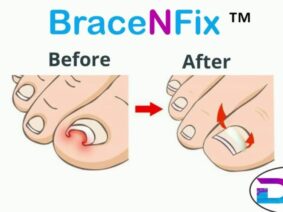It is of vital importance to take good care of your feet to produce the best results on the golf course. Not only is there great need for motion in the feet during the swinging of a golf club, the average round of 18 holes entails several kilometres of walking.
During the golf swing the body acts as a whip, power production starts with the feet pushing against the ground. Each foot moves differently during a golf swing, the back foot must allow for more pronation during the follow through of the golf swing than the front foot. This motion repeated over an extended period of time can easily lead to the various golf foot injuries discussed below.
Lower Back Pain and stiffness in the back and neck are usually caused by the twisting motion of the golf swing as the shoulders rotate around the hips. One of the most common causes of lower back pain is over pronation in the feet. Even a slight postural misalignment caused by over pronation can lead to back pain.
Common Golf Foot Injuries
Heel Spur is an overuse injury that is associated with pain on the bottom of the heel. This can be treated with custom orthotics, stretching exercises, and cortisone injections.
Neuromas are an inflammation of the nerves between the metatarsal bones. The treatment consists of wider shoe gear, orthotics, injections, or in some cases removal by surgery.
Metatarsalgia is pain across the ball of the foot. This is often caused by excessive pressure of a golf spike under the metatarsal. Sometimes removal of a spike or purchasing golf shoes that allow multiple spike placement helps with this condition. Other treatments include orthotics, padding, or medication. Corns and Callous are thickening of the skin on the foot. These are often caused by the pressure of a bone that is not properly aligned. Sometimes they are extremely painful. A podiatrist can often shave the corn or callous and pad the area to relieve the pain. If that does not work sometimes surgery is necessary.
Blisters are a common problem at the end of a round of golf. It is best to leave the blister alone. If pain persists see a podiatrist to have it drained and padded. Once driven by fashion, golf shoes were wing tip dress shoes with spikes. It is now accepted that golf shoes should be designed as an athletic shoe with spikes. Some golf shoes utilize advanced technological innovations that allow them to have increased support while remain light and flexible.
Tendonitis or Inflammation of the tendon that runs along the arch region. This is a common golfing injury as the foot can be placed under excessive pressure during the golf swing.
If biomechanical imbalances are present, these existing stresses will overload certain structures, and predispose the golfer to overuse of muscles and strain on ligaments and tendons.
Orthotics / Insoles and Golfing Injuries
Insoles allow a golfer’s body to establish a better point of contact with the ground when executing a golf swing.They will also stabilise your feet, evenly redistribute weight and correct your entire body posture during the golf swing.
Insoles also prevent and treat a variety of painful injuries that can affect your concentration and ultimately your golfing handicap. Bringing painful knees, legs, feet or an aching lower back to the fairway can prevent you from playing to the best of your golfing potential!
When injured, participation is no substitute for rehabilitation. Injured body parts must be thoroughly treated and rehabilitated to meet the full demands of golf or any other sport. If you are injured, your return should be gradual. As much as you may want to get back to your game, take it slow. A healthy body makes for a more enjoyable game, and possibly a better scorecard at the end of the day.





